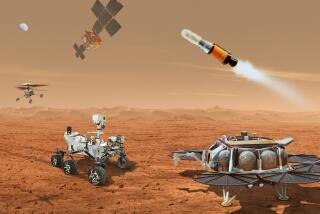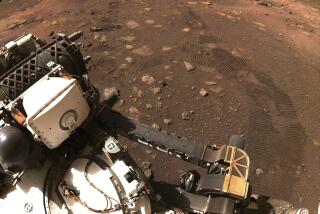NASA’s MAVEN mission seeks answers about Mars’ atmosphere
- Share via
Four billion years ago, rivers and lakes dotted the surface of Mars, their waters reflecting puffy clouds drifting in a blue sky, scientists believe.
Now, it’s a dry, rusty rock that’s subject to fierce sandstorms, withering blasts of radiation and freezing temperatures that have frozen carbon dioxide to the planet’s poles.
What happened?
That’s the question NASA seeks to answer with the scheduled launch Monday of the MAVEN spacecraft.
Planetary scientists believe the answer lies high in the Martian atmosphere. Today, it’s a thin layer of mostly carbon dioxide gas. But long ago, it may have been thick enough to host a life-friendly, even Earth-like, environment. If so, the Mars Atmosphere and Volatile EvolutioN mission may reveal clues about where it all went.
Previous missions, from rovers to orbiters, have tried to see into the Red Planet’s past by examining its surface. But that only tells part of the story, said Bruce Jakosky, a planetary scientist at the University of Colorado-Boulder and principal investigator for the MAVEN mission.
“If we want to understand Mars as a system, we need to include the role of the upper atmosphere,” he said. “We can no longer just look at the geology and understand it in isolation.”
Earth is flanked by two alternative worlds. On the side closer to the sun is Venus, a planet with too much atmosphere, boiling away under thick layers of carbon dioxide. On the other side lies Mars, a planet with too little air shielding its cold, dead deserts.
“We think all three of those planets, when they formed, were not all that different,” said Steven Lee, curator of planetary science at the Denver Museum of Nature and Science. Life arose on Earth because it’s a “Goldilocks” case, protected by just the right amount of air.
Robotic explorers sent to Mars by NASA and other space agencies have already picked up many signs that water once flowed across the surface. Scientists have identified craters that they think were once filled with lakes, along with clay minerals that must have been formed by exposure to water.
“I wouldn’t be surprised if, for many tens of millions of years, Mars was a pretty friendly place with natural water, wind, waves and rain,” said Paul Mahaffy, an atmospheric scientist at NASA’s Goddard Space Flight Center in Greenbelt, Md., who leads instruments on both MAVEN and the Mars rover Curiosity. “But I think we just don’t know.”
Liquid water can’t exist on the Martian surface today — it would quickly freeze in the coldest spots and boil off elsewhere, because the low-pressure atmosphere is far too thin to keep it in.
Understanding why Mars’ atmosphere vanished and Earth’s did not is key to understanding Earth’s ancient history. Someday, it may even help scientists study the atmospheres of planets orbiting distant stars.
There are several theories about why the Martian atmosphere has been reduced to a wisp. Some researchers think a giant catastrophic impact blew out much of the atmosphere. Others suspect that much of the carbon dioxide may have been sunk into Mars’ rocks in the form of carbonates. But neither of these explanations can fully account for the massive loss of water vapor and gas.
The sun, many experts believe, is the most likely culprit — and it has been whittling away at the outer edge of the Martian atmosphere for billions of years. Unlike Earth, which is protected from the sun’s radiation by a strong magnetic field, Mars has little defense against solar erosion. This may be because the planet’s inner dynamo cooled long ago, while Earth’s molten core keeps churning.
MAVEN will study solar erosion in the Martian atmosphere with a suite of sensitive instruments that can pluck ions and electrons from the solar wind, analyze energetic particles from the sun and examine faded magnetic fields.
MAVEN also has tools to analyze the gas near the top of the Martian atmosphere. Elements, like hydrogen or nitrogen or argon, typically come in slightly heavier and slightly lighter versions, called isotopes. As an atmosphere slowly escapes over time, the lighter isotopes tend to flee faster than the heavier ones. So if the scientists find that many of the lighter isotopes are missing, it will give them a clear sense of how much of the atmosphere has escaped into space — and thus, how much more of it there must have been in the past.
The scientists hope they’ll be able to catch a Martian aurora in action, which could provide insight into weak patches of magnetic field that still exist on parts of Mars. They’ve also got their fingers crossed that a few solar storms will hit the planet during the mission, so that MAVEN can witness the type of solar pummeling they think would have been common in the past, when the sun was far more active.
Unlike Curiosity, which captured hearts, minds and 1.4 million Twitter followers around the globe, MAVEN isn’t likely to be much of a scene-stealer. It doesn’t have cameras that can take breathtaking panoramas or cheeky self-portraits.
But both Curiosity and MAVEN have common goals: understanding how life-friendly this cold, red rock really could have been — and how long those conditions could have lasted. The longer the atmosphere was thick, the more likely that life would have had a chance to take hold.
If Monday’s planned launch is delayed by bad weather or unforeseen glitches, NASA will have until mid-December to get off the ground. After that, Mars and Earth will be too far away for MAVEN to get there on its limited fuel supply.
MAVEN was in danger of missing its launch window altogether when the federal government shut down on Oct. 1, putting 97% of NASA’s employees temporarily out of work and leaving the mission team at NASA’s Kennedy Space Center in Florida in a lurch.
If the mission stalled and the launch window passed, team members would have had to wait more than two years for their next chance. By that time, the spacecraft’s instruments would have aged and the cost of storing it would have added to the mission’s price tag.
On top of that, the sun would have gone into a quieter phase of its 11-year solar cycle. MAVEN scientists would have missed their shot at key data that could have helped them understand the ancient, more active sun.
It was Curiosity that saved MAVEN from the short-lived furlough. MAVEN has a radio relay built by the Jet Propulsion Laboratory in La Cañada Flintridge that will serve as a backup to the two aging orbiters that currently send the rover’s messages back to Earth. If both of them broke, MAVEN would have to provide that link.
Other than that, the mission has gone remarkably smoothly, said MAVEN project manager David F. Mitchell of the Goddard Space Flight Center. MAVEN is on time and appears on track to come in below its approximately $671-million budget, a point of pride among the team.
After MAVEN completes its 10-month trip to Mars, it’s scheduled for a primary mission of one year, though the hope is that it will last much longer.
Jakosky says MAVEN has dominated his life in recent years. He even made special coupons for his wife, worth a few hours of MAVEN-free conversation.
They came with an asterisk: not valid for launch day.







